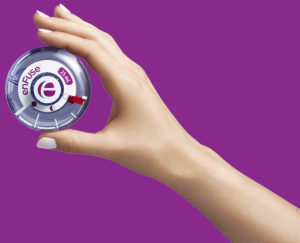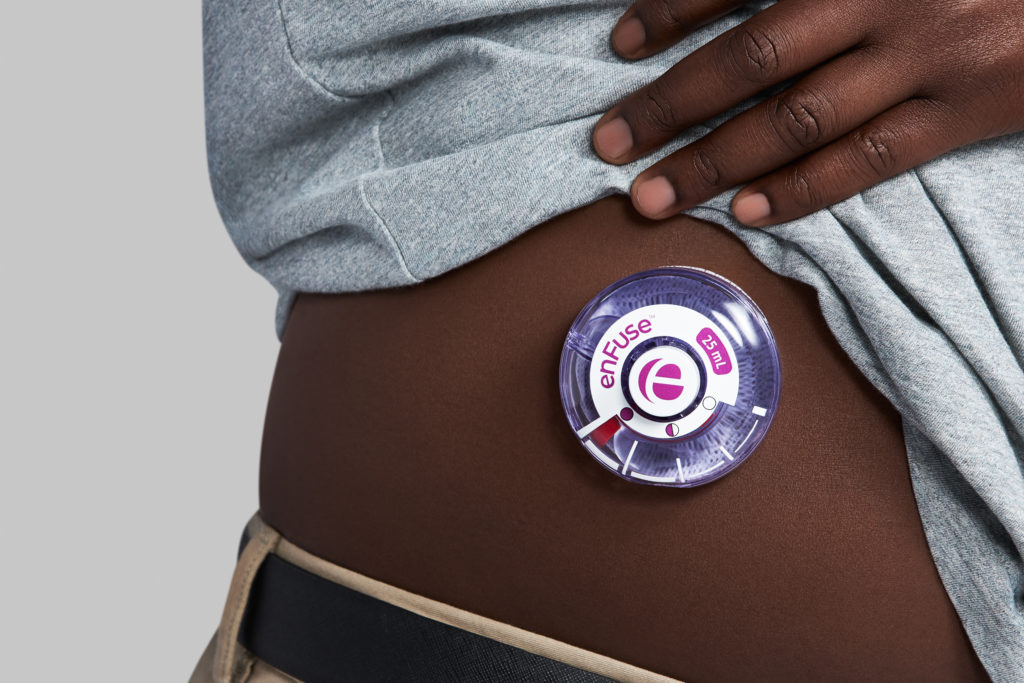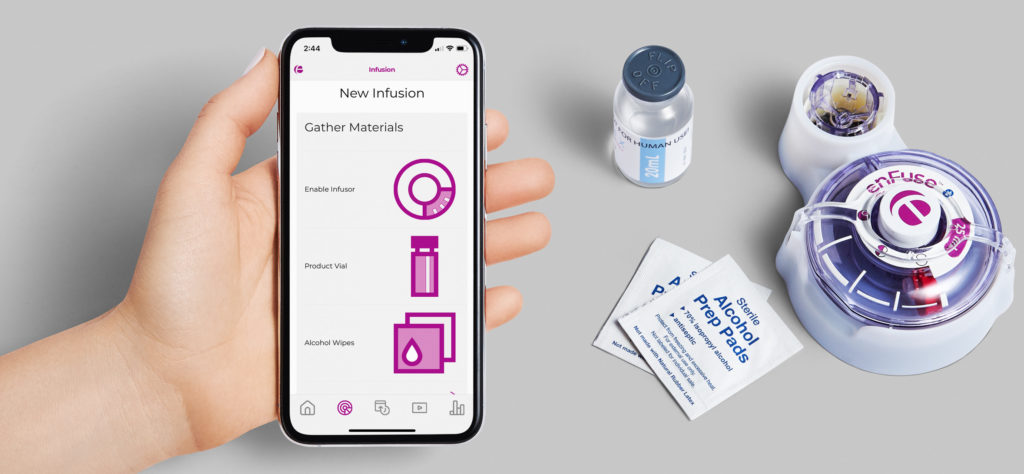Citation: Huddleston M, Estep J, “Drug Delivery: What do Patients and Providers Want?” ONdrugDelivery, Issue 124 (Sep 2021), pp 10–14.
Matthew Huddleston and Jennifer Estep discuss current drug delivery options and the value of convenient care.
Worldwide, patient and provider preferences are changing due to the covid-19 pandemic. The need to reduce patient exposure to the virus and free up healthcare resources is driving unprecedented change.
For patients, providers and healthcare systems, the need for more flexible, convenient medical treatment has never been greater. While innovations that improve patient access to care evolve, understanding the needs and wants of patients and providers is more important than ever.
CURRENT DRUG DELIVERY OPTIONS
IV Administration
Consider these facts:
- The average time required to place an IV line is 13 minutes1
- IV placement attempts fail 26% of the time in adults and 54% of the time in paediatrics2
- More than one billion IV lines are used annually, worldwide3
Not only are patients unwilling to spend hours in a healthcare facility receiving IV infusions, covid-19 is preventing patients from going into the hospital or clinic. Creative solutions can help improve patient access to care. For example, one provider in Florida (US) has made infusions more accessible to cancer patients by creating a drive-through IV clinic. However, given the amount of time required per IV placement and the IV placement failure rate, it is not surprising that patients prefer subcutaneous (SC) delivery over IV infusion.4
The Step Forward With SC Administration
SC administration enables more flexible delivery options for both the patient and the provider. Current approved delivery options include syringes, autoinjectors, syringe pumps and bolus injectors, which may allow for patient self-administration. However, the full potential of SC delivery has been held back.
Availability of SC Therapeutics – To date, the number of therapeutics marketed for SC administration is limited despite the advantages SC has over IV administration.
Volume Limitations – Autoinjectors and syringes traditionally have limits on the volume of therapeutic which can be delivered, typically less than 1.5 mL. This small volume presents formulation challenges to pharmaceutical companies.
Administration Challenges – Larger volumes delivered with a syringe often require administration by a healthcare professional (HCP). Syringe pumps and bolus injectors allow delivery of greater volumes but require tubing sets, exposed needles and large, cumbersome systems.
In addition to limited therapeutics and delivery volume challenges, several myths plague SC delivery, presenting challenges to its widespread acceptance.
“To deliver volumes necessary to gain therapeutic benefit and allow patients to self-administer therapies on their own, innovative new SC delivery alternatives are needed.”
THREE SUBCUTANEOUS DELIVERY MYTHS
- Injection Time There is a belief that the quicker the administration, the better for a patient, caregiver and provider. However, this is often not the case. If the person receiving the treatment is mobile, untethered and not feeling like a patient during an administration,5 delivery time becomes irrelevant.
- Number of Needles Recent preference studies have asked patients about the number of needles that they will tolerate per dose. In the studies, patients were questioned about their preference using two different methods: one method being the completion of a questionnaire and the second method involving the administration and receipt of a dose. Upon evaluation of the results, a difference in patient response was identified. When required to administer several needlesticks for a dose, patients in the survey preferred fewer needlesticks and were less likely to state they prefer SC administration with autoinjectors or syringes.6 In general, patients do not like to see or handle needles7 and prefer fewer needlesticks for a single dose.
- Need for a Permeation Enhancer While the use of permeation enhancers has provided valuable efficiencies for in-clinic compared with traditional IV administration, multiple studies demonstrate that large volumes8,9,10 administered into the SC tissue with the right delivery technology do not require an enhancer. The use of an enhancer requires addition of further formulation work, clinical trials, packaging and administration steps to the original therapeutic. Lastly, these permeation-enhanced products are typically delivered with a needle and syringe, relegating them to hospital/in-clinic, HCP-supervised use.
In order to deliver volumes necessary to gain therapeutic benefit and allow patients to self-administer therapies on their own, innovative new SC delivery alternatives are needed.
THE VALUE OF CONVENIENT CARE
Convenience and access to care have an impact on patient adherence to prescribed treatments – but how impactful is convenience on patient adherence? Consider the following:
- Patients want convenience. NRC Health’s Market Insights11 surveyed more than 223,000 healthcare consumers and found that 51% said convenience and access to care are the most important factors in their decision making. That’s above insurance coverage (46%), doctor/nurse conduct (44%), brand reputation (40%) and quality of care (35%)12,13
- The US Congressional Budget Office estimates that a 1% increase in the number of prescriptions filled by beneficiaries would cause Medicare’s spending on medical services to fall by roughly 0.2%14
- In a systemic review assessing the cost of non-adherence across 14 diseases, the annual adjusted disease-specific economic cost of non-adherence per person ranged from US$949 (£691) to $44,19015
- Medication adherence leads to lower healthcare use and costs despite increased drug spending.16

Figure 1: Meet enFuse – a wearable drug delivery solution.
MEET ENFUSE: ENABLING ENYWHERECARE™
“The most important benefit of the enFuse platform would be the improvement of the quality of life – keeping patients out of the clinic and infusion chair.” – KOL, Scientific Advisory Board of three top-10 pharmaceutical companies.
The enFuse® is perfectly suited for flexible care (Figure 1). Enable’s flexible delivery model, EnywhereCare with enFuse, enables a range of delivery options for patients and providers, from in-clinic to at-home self-administration of therapeutics.
The focus at Enable Injections is on the patient (Figure 2). In the past year, the company has had the ability to learn from patients’ actual experiences with the enFuse. Two clinical trials with partners have concluded successfully, and it has received an overwhelming positive response from both patients and providers. In these clinical trials, Enable Injections proved that subcutaneous delivery of large volumes – 50 mL and more – can be delivered successfully via the enFuse without the use of permeation enhancers. For patients currently receiving care with large-volume SC delivery systems, 100% of the patients in a clinical trial reported they prefer the enFuse over their current method of SC delivery.

Figure 2: Drug delivery redefined with the patient in mind.
As patient care transitions to the home in a flexible care model, patients will increasingly rely on delivery technology to provide solutions to connect with their physicians and other patients, as well as provide training, reminders and validation of injection success. One of the many ways in which Enable is working to provide this type of flexibility is through the development of the Smart enFuse (Figure 3). The Smart enFuse is being developed to support next generation patient-HCP connections and enables increased flexibility in the site of care. The enFuse allows flexibility for the patient and provider – enabling administration of therapeutics both inside and outside the clinic, including self-administration at home.

Figure 3: Smart enFuse supports next-generation patient-HCP connections.
Administration with enFuse does not require a permeation enhancer. Thus, enFuse may provide advantages for pharma partners over SC products paired with permeation enhancers, including potential reduced risk, cost and time to market (Table 1). The mission of Enable Injections is to enable convenience for the patient, with the goal of making a positive difference in patient compliance and adherence.
| Route of Administration |
Benefits | Disadvantages | Limitations |
| IV | Large volume, low-pressure delivery, extended delivery time possible |
HCP required, exposed needle/catheter, difficult administration |
Site of care, venous access, number of ports in patient lifetime |
| SC via autoinjector |
Portable | Limited delivery volume, large needle, multiple injections needed for a single high dose, discomfort |
Volume, high-pressure delivery |
| SC via syringe + permeation enhancer |
Duration for in-clinic injection may be shorter than IV infusion |
Must be in-clinic. May not reduce HCP time per patient – long-held injection, angle, HCPs do not prefer, additional clinical trials required, additional formulation required, large needle |
Requires continuous HCP time to introduce enhancer, high-pressure delivery |
| SC via syringe pump |
User self-administration possible, precise and extended delivery time possible |
Cumbersome, patient immobile for long period of time, numerous user steps required, exposed needle sets, tubing |
Difficulty of administration and steps involved, high-pressure delivery |
| SC via enFuse | Wearable, simple, flexible, not exposed to needle, large-volume, low-pressure delivery, small needle |
Not yet available | Not an extended or precision delivery profile |
Table 1: Drug delivery at a glance.
WHAT DO PATIENTS SAY?
“It is difficult for me as a patient to feel as though someone making the decisions in pharma grasps the various intricacies of patient care. The ease of flowing back and forth between different types of applications – clinic versus home and back again – is such a key insight! The treatment centre I go to tries to model this concept – being flexible based on patient needs – but the one restriction has always been the drugs and which ones are available for administration outside the clinic. I’ve tried SC, but the way it had to be administered in large volumes with pre-admin of hyaluronic acid and using multiple needles, etcetera, was just impossible. enFuse is a game changer.” – Patient, after education on enFuse.
CONCLUSION
Patients often say they want to feel less like a patient and more like a healthy human being. In a study of patients participating in studies during the pandemic, the option to participate in trials at home increased the respondents’ likelihood of participating in trials, which helped improve the overall patient experience.17
The pandemic has thrown a spotlight on the need to improve the patient convenience aspects of treatment and allow for flexibility in the setting of administration, based on the physician’s and patient’s preferences and needs. Enable plans to continue to focus on delivering enFuse technology for its pharma partners, and on improving the patient and provider experience.
REFERENCES
- Raymond K, “Intravenous (IV) Line Access”. iEM.
- Sabri A et al, “Failed Attempts and Improvement Strategies in Peripheral Intravenous Catheterization”. Biomed Mater Eng, 2013, Vol 23(1), pp 93–108.
- Beecham G et al, “Peripheral Line Placement”. StatPearls, 2020.
- “Participant Preference of Subcutaneous (SC) Versus Intravenous (IV) Herceptin (Trastuzumab) in Human Epidermal Growth Factor Receptor (HER) 2-Positive Early Breast Cancer (PrefHER)”. Hoffmann-La Roche, 2015.
- Knight S, “Humanizing Healthcare: Hardwiring Humanity into the Future of Health”. McGraw Hill, Apr 2021.
- Overton P et al, “Patient Preferences for Subcutaneous versus Intravenous Administration of Treatment for Chronic Immune System Disorders: A Systematic Review”. Patient Prefer Adherence, 2021, Vol 15, pp 811–834.
- McLenon J, Rogers M, “The fear of needles: a systematic review and meta-analysis”. Wiley, 2018, DOI: 10.1111/jan.13818.
- Johnson M et al, “Assessment of Subcutaneous vs Intravenous Administration of Anti–PD-1 Antibody PF-06801591 in Patients With Advanced Solid Tumors: A Phase 1 Dose-Escalation Trial”. JAMA Oncol, 2019, Vol 5(7), pp 999–1007.
- O’Brian M et al, “Subcutaneous REGEN-COV Antibody Combination to Prevent Covid-19”. NEJM, Aug 2021.
- “Safety and Tolerability of Higher Infusion Parameters of IgPro20 (Hizentra) in Subjects with Primary Immunodeficiency (PID)”. CSL Behring, 2020.
- Masterson L, “Convenience more important to patients than quality of care, survey finds”. HealthcareDive, 2019.
- Roebuck et al, “Medication Adherence Leads to Lower Health Care Use And Costs Despite Increased Drug Spending”. Health Aff, 2011, Vol 30(1).
- “2019 Healthcare Consumer Trends Report”. NRC Health, 2019.
- “Offsetting Effects of Prescription Drug Use on Medicare’s Spending for Medical Services”. Congressional Budget Office, Nov 2012.
- Cutler et al, “Economic impact of medication nonadherence by disease groups: a systematic review”. 2018.
- Yeam CT, Chia A, Tan HCC et al. “A systematic review of factors affecting medication adherence among patients with osteoporosis”. Osteoporosis Intl, 2018, Vol 29, pp 2623–2637.
- Ali Z et al, “Virtual Clinical Trials: Perspectives in Dermatology”. Dermatology, 2020, Vol 236(4), pp 375–382.

